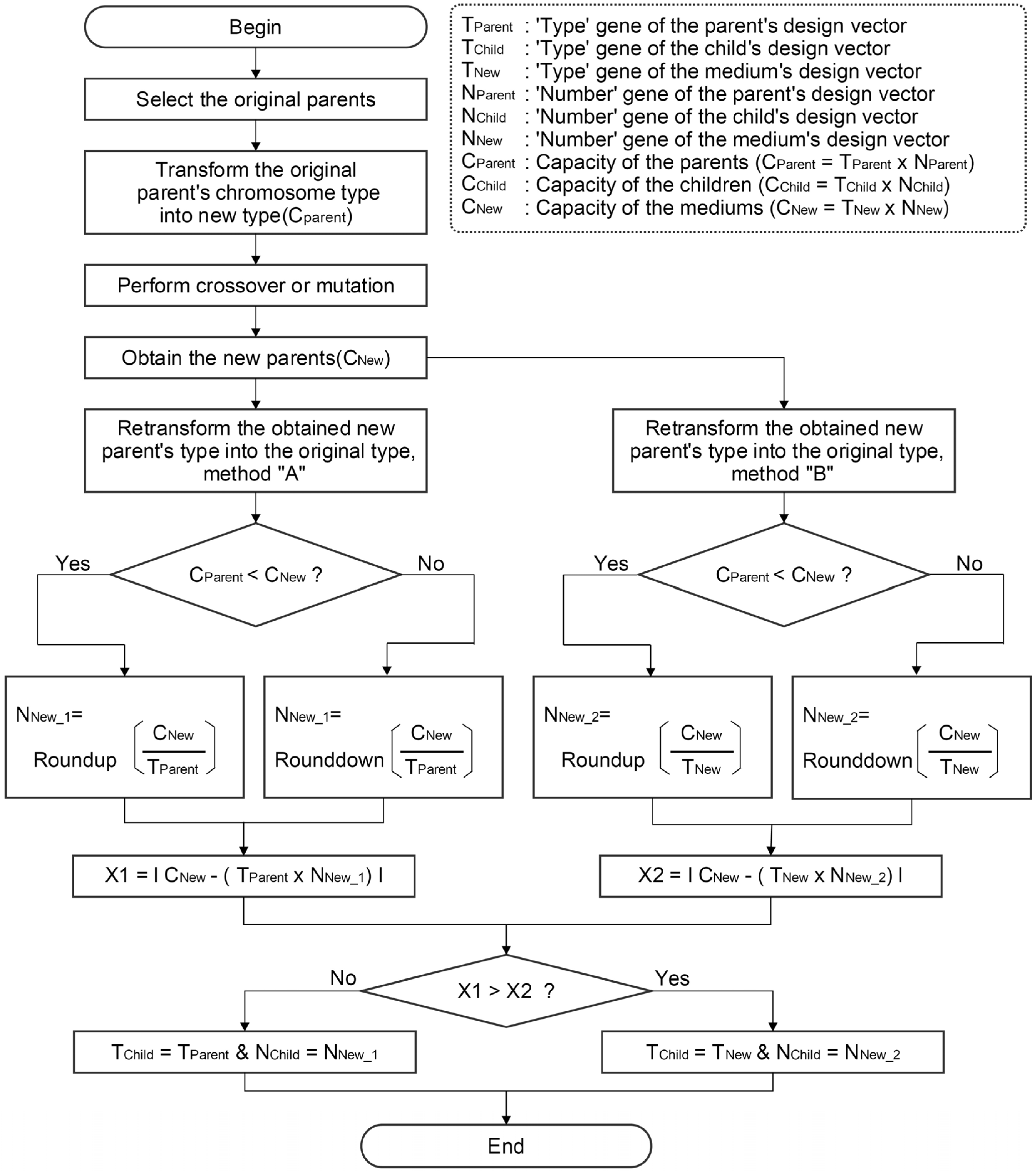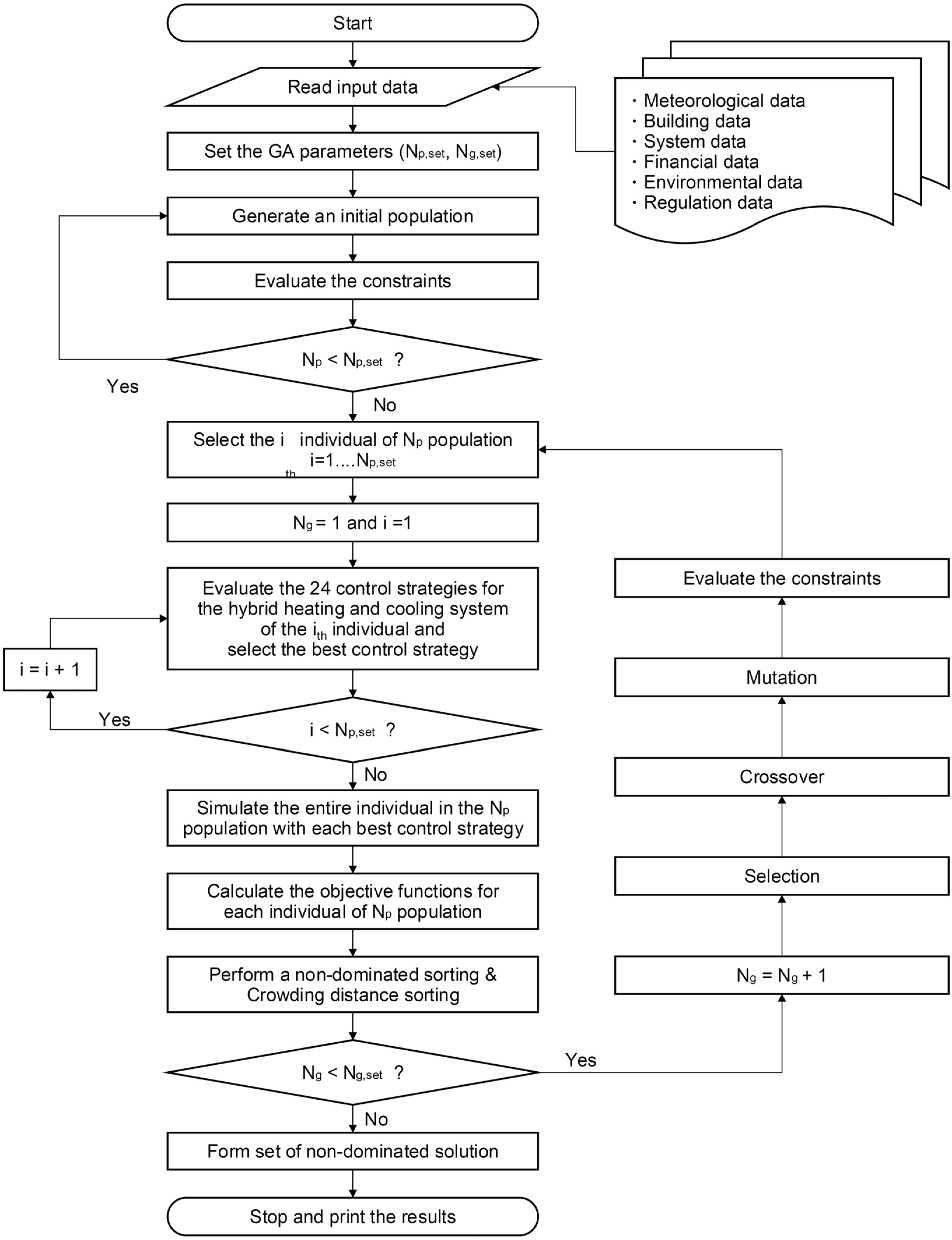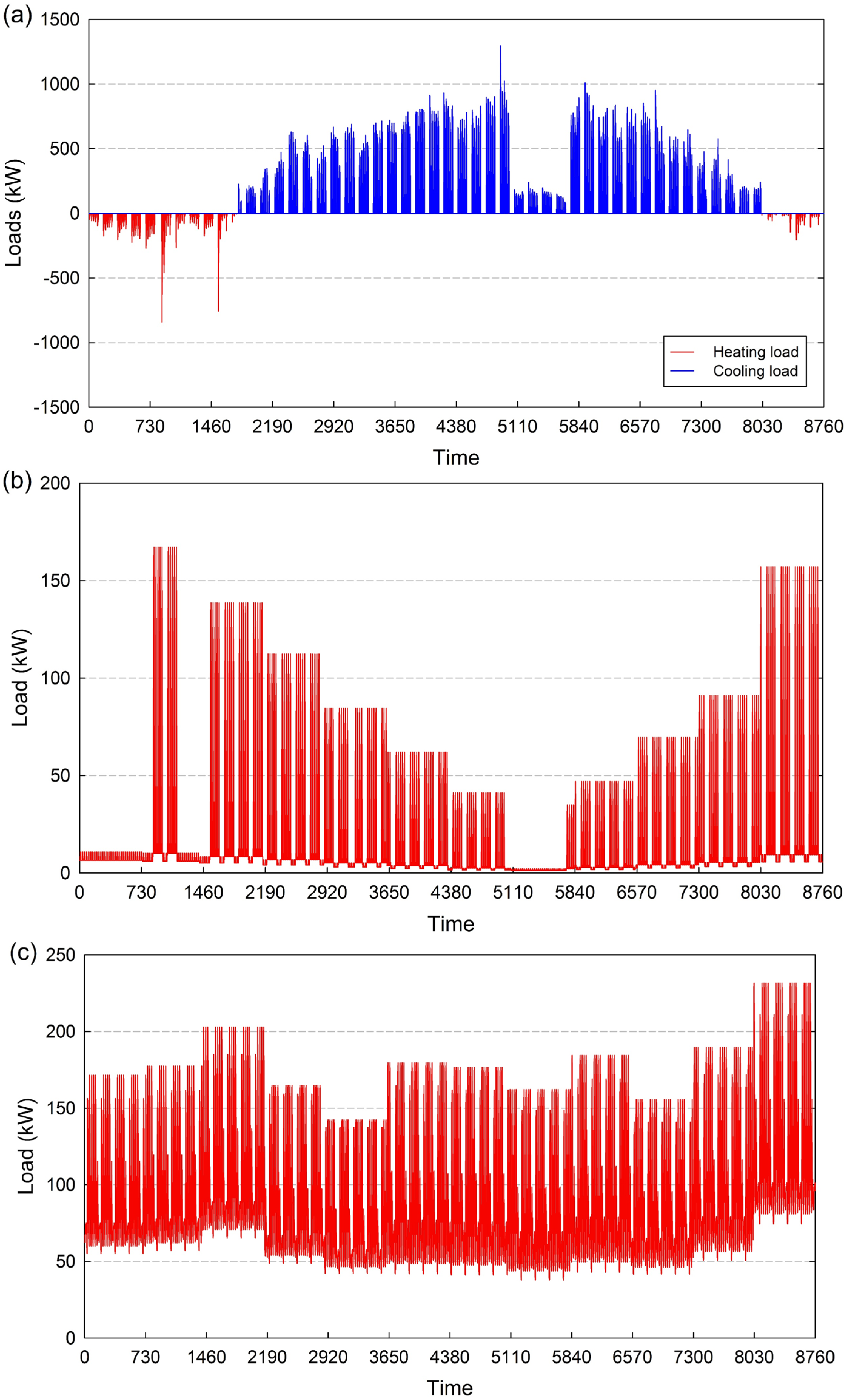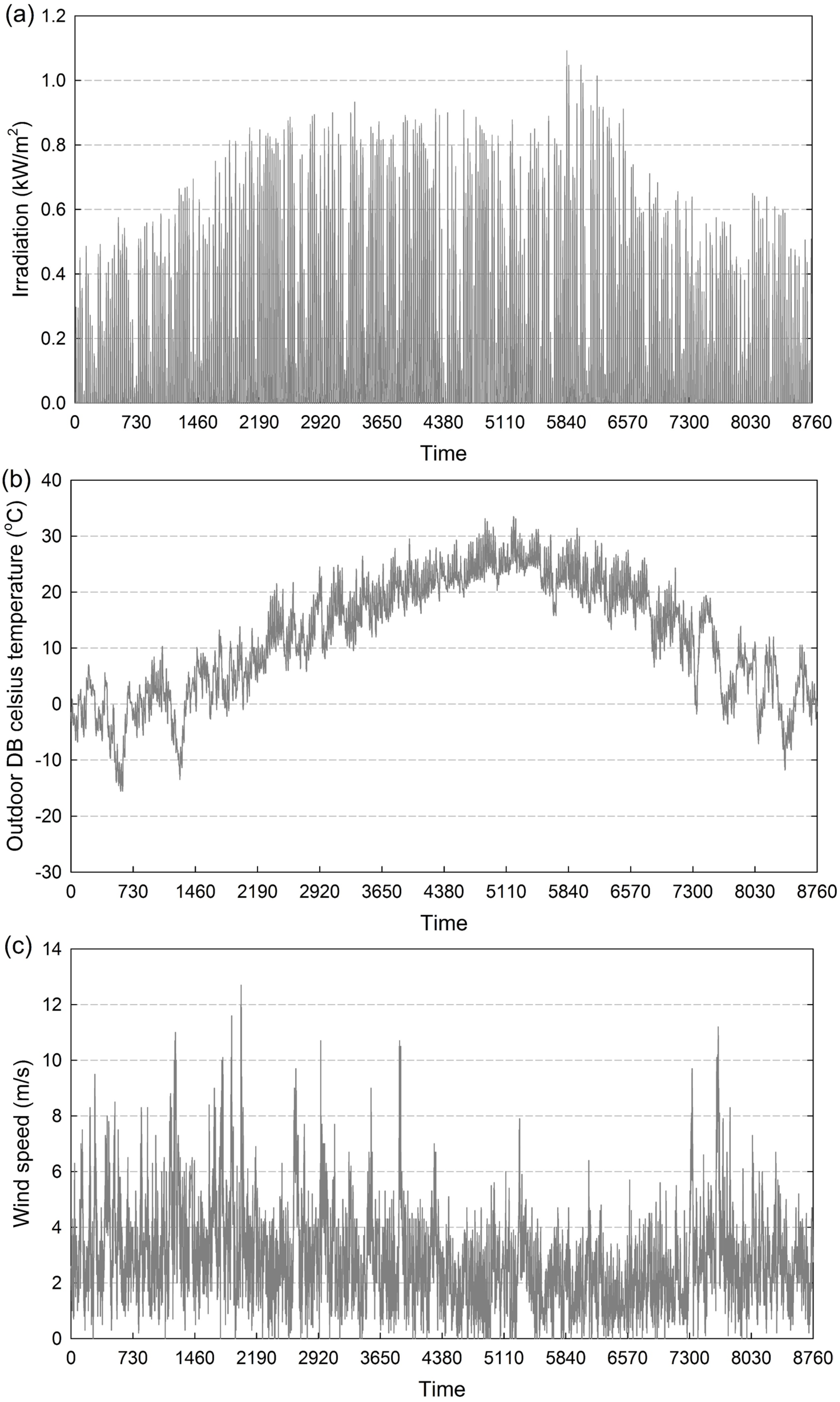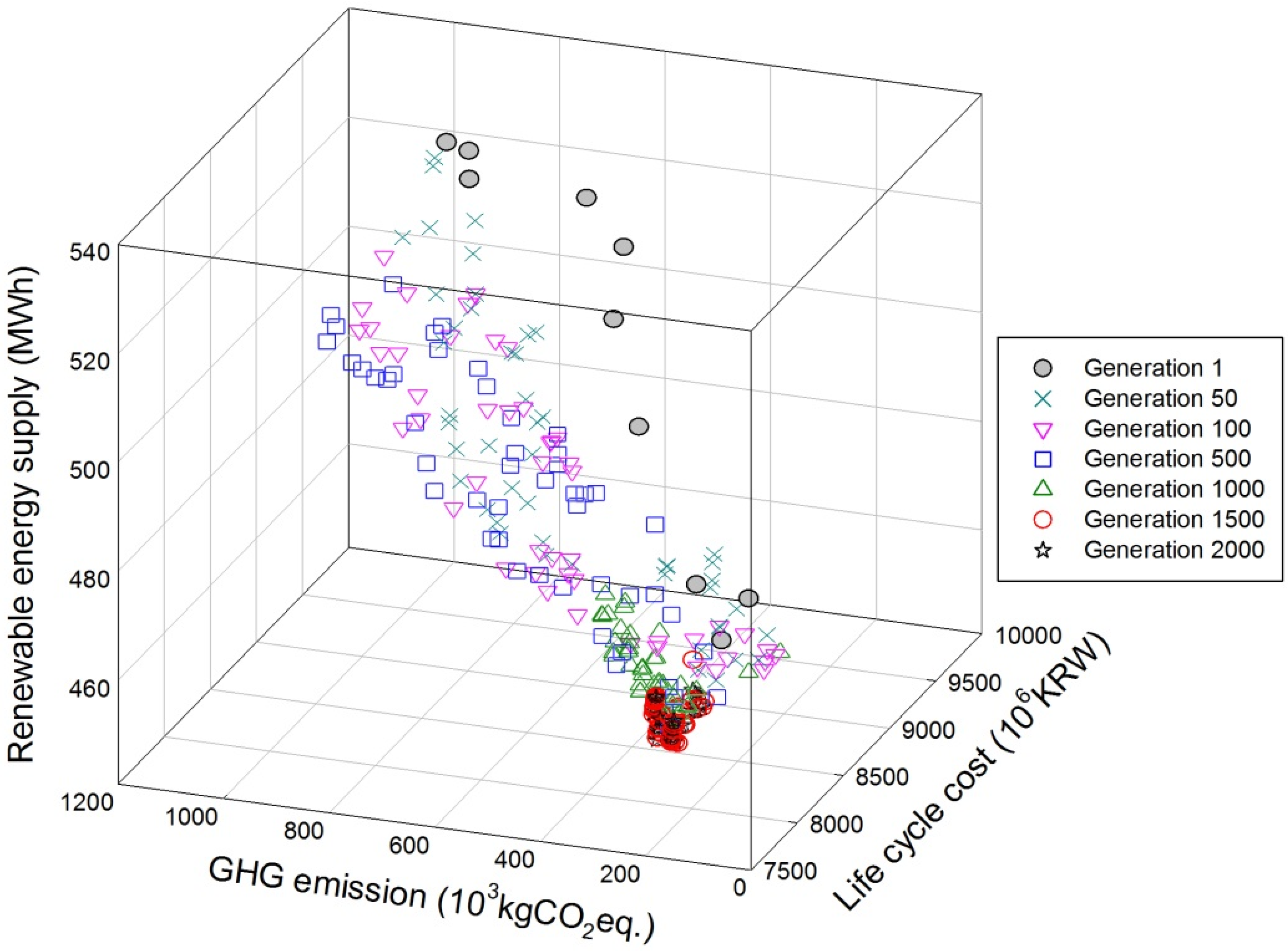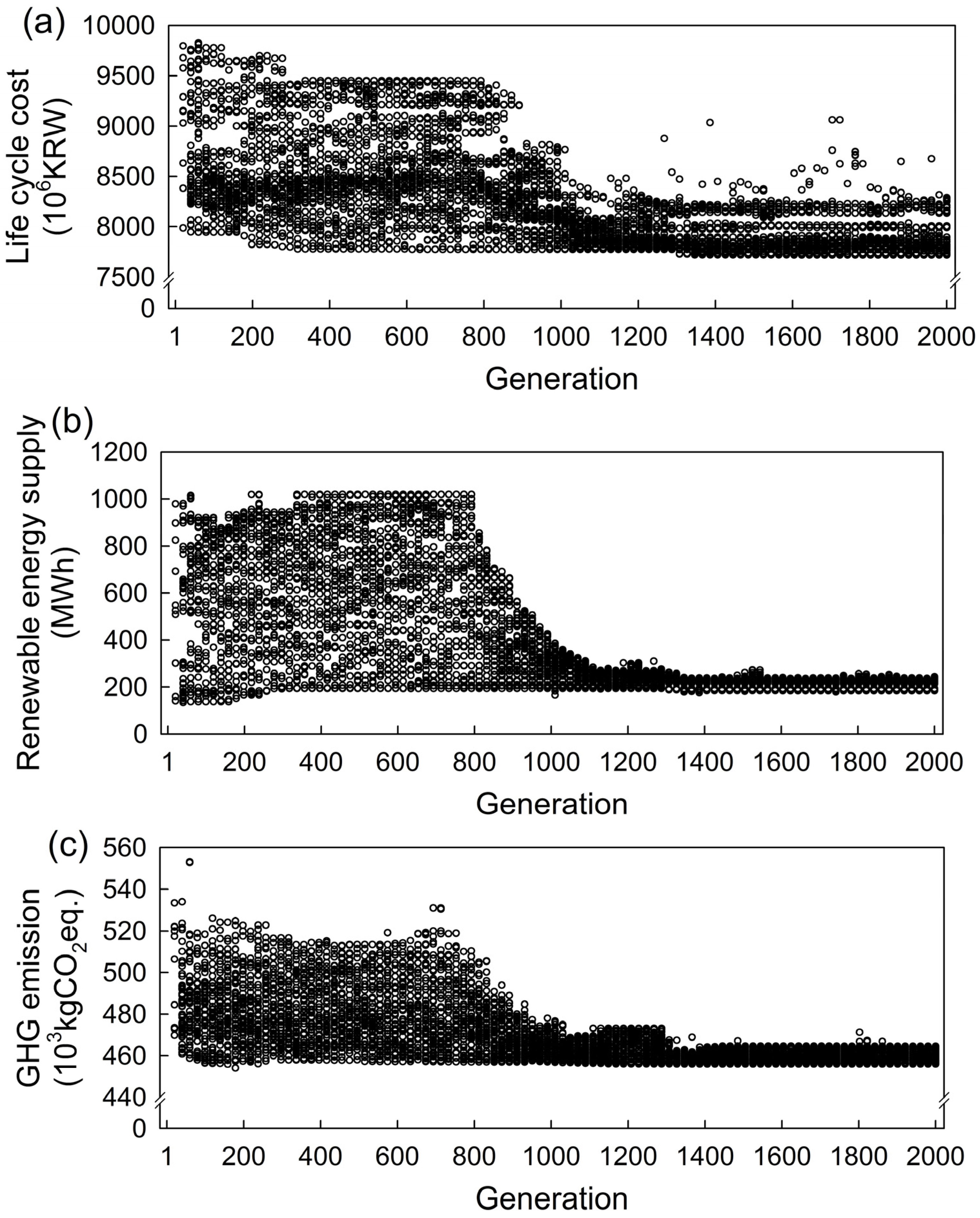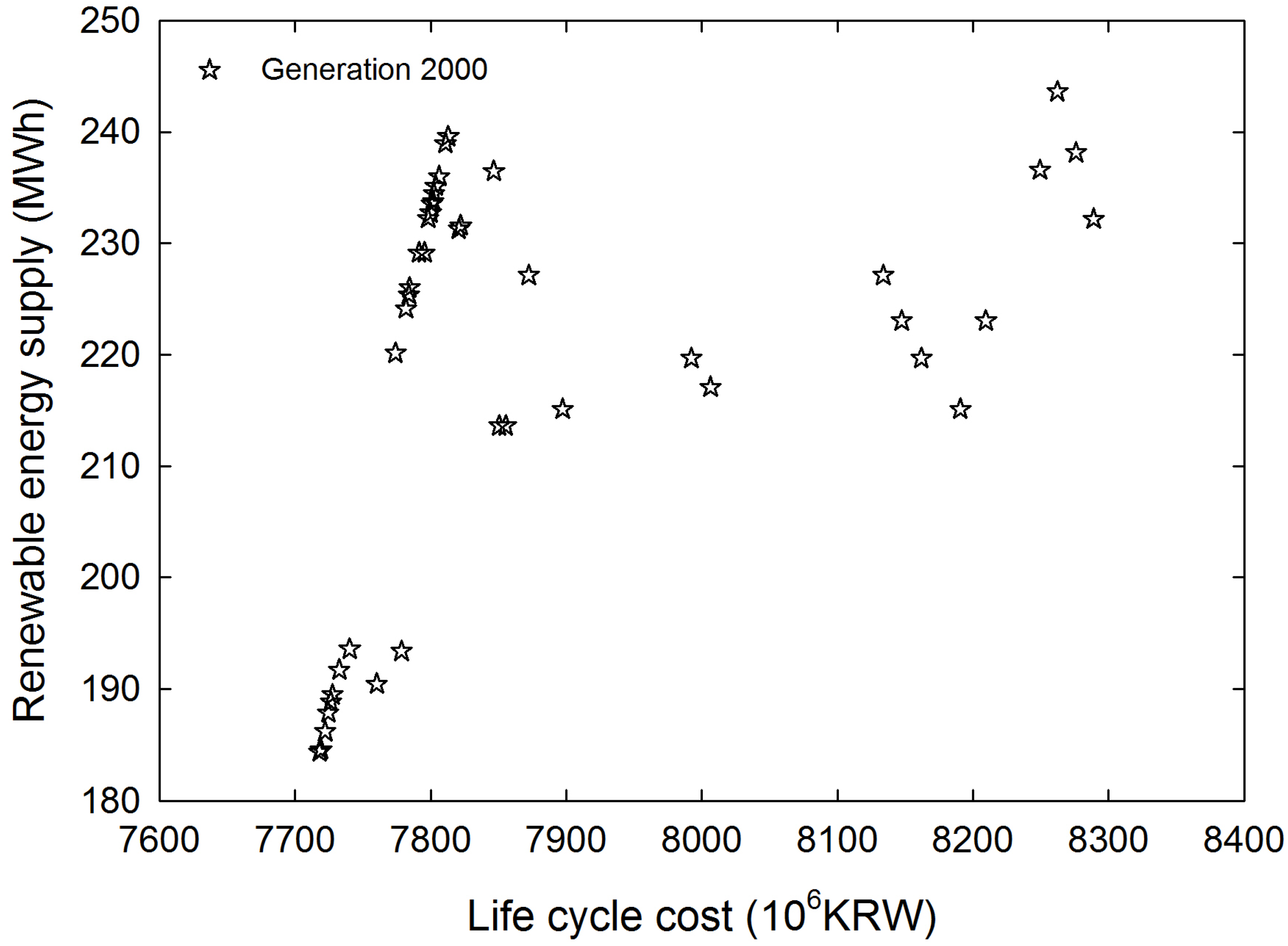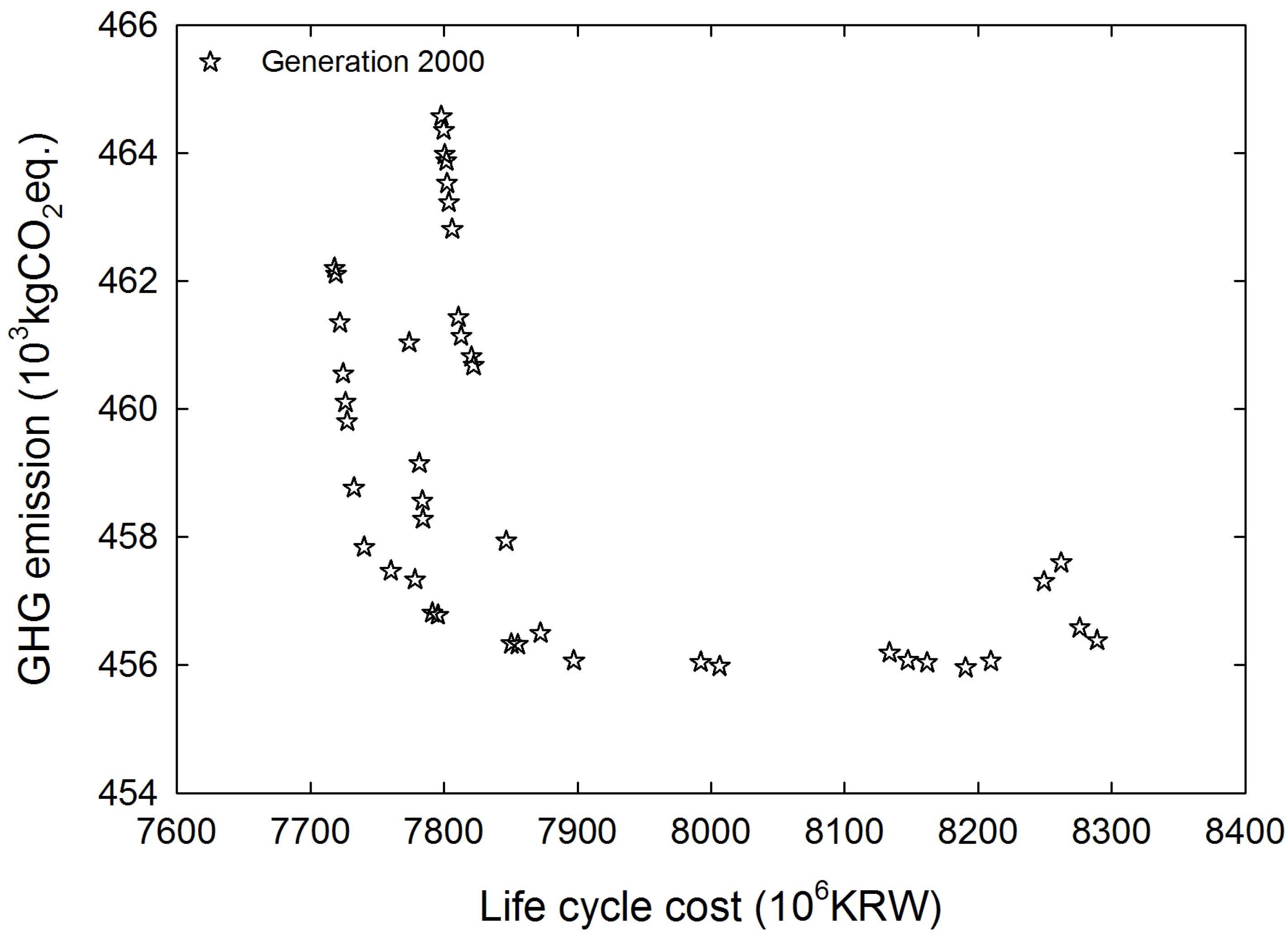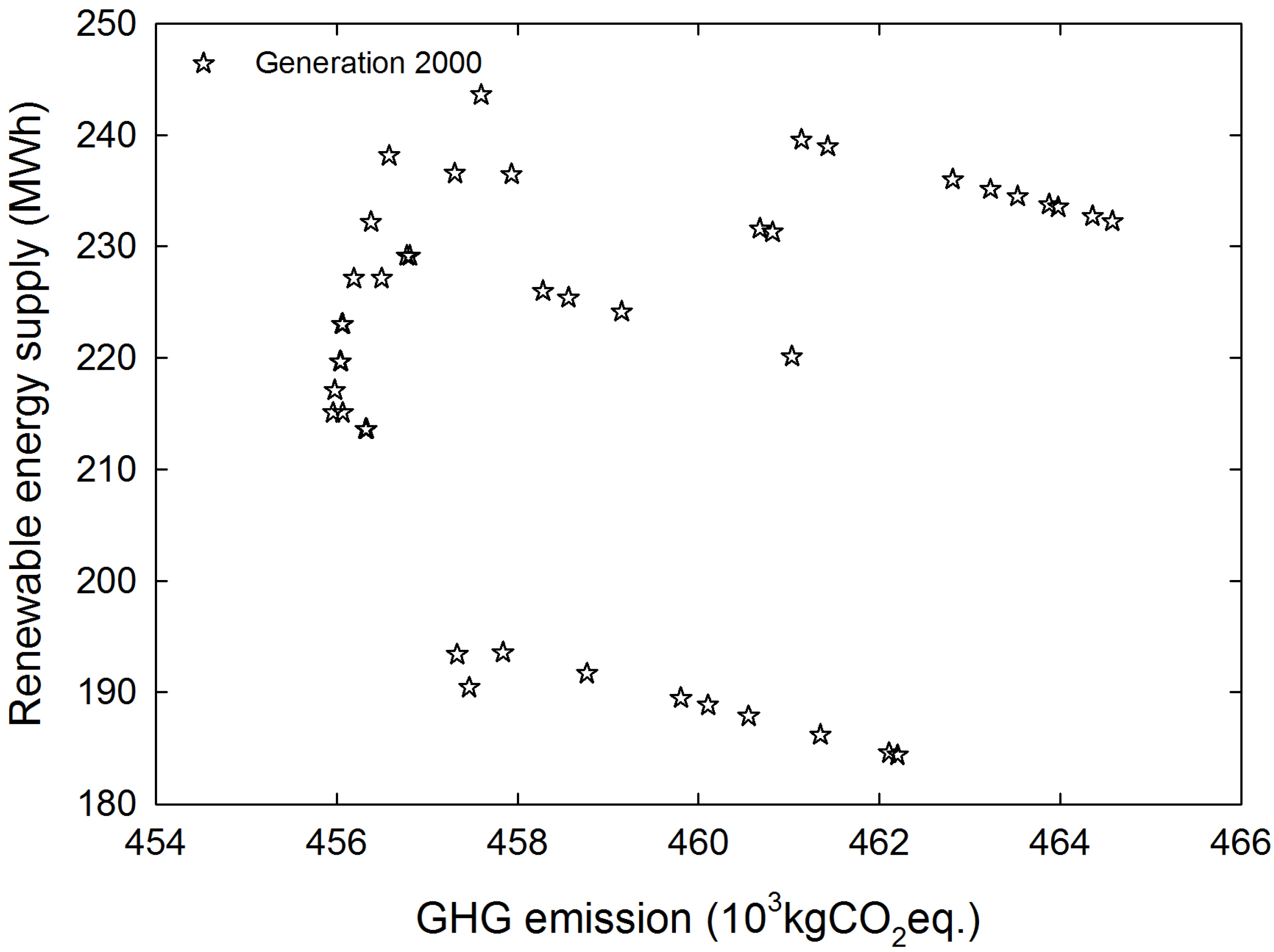1. Introduction
In many countries, the energy consumption of buildings accounts for 40% of the total energy consumption and 40% of all greenhouse gas emissions [
1,
2]. To solve these energy and environmental issues, new and renewable energy systems (NRESs) are being introduced rapidly. These energy systems reduce the consumption of fossil fuel energy by enabling energy to be self-produced at buildings and sites. However, such systems use natural energy, the production of which is intermittent and volatile, and they have relatively high initial investment costs.
To overcome these issues, many researchers have been interested in the optimal design for hybrid renewable energy systems. Diaf
et al. [
3] studied the technical-economic optimization of the stand-alone hybrid PV/wind system (HPWS). Koutroulis
et al. [
4] presented a methodology for optimal sizing of a stand-alone electric system comprised photovoltaic (PV), wind turbine and battery storage. To design the HPWS, Yang
et al. [
5] studied the optimal sizing method to calculate the optimum system configuration that can achieve the loss of power supply probability (LPSP) with a minimum annualized cost of system and Yang
et al. [
6] have applied the method to the analysis of a HPWS which supplies power for a telecommunication relay station.
Nevertheless, the use of NRESs is not as economically feasible as fossil fuel energy systems (FFESs). Thus, to secure a stable supply of renewable energy within a reasonable cost range, hybrid energy systems (HESs) that integrate both FFESs and NRESs must be designed and applied. In recent years, studies on the optimal design of these HESs have been carried out by a number of researchers. Dufo-López
et al. [
7] presented an optimization method that designs the sizing and operation control of a PV-Battery-Diesel system with the minimum total net present cost by a genetic algorithm. Then, the research team, including Dufo-López, [
8,
9,
10] studied the optimal design of a PV-Wind-Battery-Diesel system according to the objective functions, the operation strategies and characteristics for load profiles. Chen [
11] researched on an optimization methodology for the installation capacity of a stand-alone PV-Wind-Battery-Diesel system, taking into consideration the cost and reliability. Zhao
et al. [
12] studied an optimal unit sizing method for the aforementioned system and applied the method to a real micro-grid system on Dongfushan Island, China. Moreover, the role of the internal combustion generator in a hybrid electric system has been discussed by Perera
et al. [
13,
14,
15,
16] by using multi-objective optimization. Furthermore, a number of research works had been done dealing with the optimal design and the sizing of HESs composed of energy technologies, such as fuel cells and bio-diesel generators [
17,
18,
19].
Most HESs in the aforementioned literatures are stand-alone hybrid electric systems that just supply electricity to a building. Because of this, growing attention has been placed on HESs providing the entire building energy load. Nosrat
et al. [
20] combined trigeneration with PV, cogeneration and absorption chiller. Rubio-Maya
et al. [
21] studied the design optimization of a polygeneration plant comprised of a solar thermal system, biomass gasification, gas turbine, fuel cell, absorption chiller, compression chiller and boiler. Jing
et al. [
22] studied the combination of PV and solar thermal, gas engine, absorption chiller and boiler. In addition, the optimization for various HES configurations comprised of NRESs and FFESs was studied by Morini
et al. [
23], Barbieri
et al. [
24] and Buoro
et al. [
25].
As previously stated, studies on the optimal design for HESs have been increasing, but studies on the optimization of HESs supplying both electricity and heat to a building are still lacking. Furthermore, most of previous studies optimized particular HESs that generally feature enhancement of applicability of NRESs and were composed beforehand by researchers. However, components using fossil fuels, such as boilers, refrigerators and heat pumps are still installed as part of the primary energy system and are unlikely to change for a considerable amount of time. To apply reasonable and appropriate HESs in buildings, development of novel methodologies are required to design an optimal size or configuration according to the design criteria among the alternative, practicable HESs that can be made up of different types of energy conversion technologies.
Therefore, this paper presents a methodology to design a HES using a multi-objective optimization with the following characteristics: this methodology determines the optimal size and configuration for hybrid cooling, heating, hot water and power systems consisting of NRESs (photovoltaic, solar collector and ground source heat-pump) and FFESs (boiler, chiller and air source heat-pump). The optimal design will differ depending on the design objectives that the researcher, investor or operators regard as the key factors in the design of an energy system. Thus, the optimal design objectives can be selected by users in the beginning of the implementation of the methodology. In addition, the results obtained with this method describe the applicable optimal size and configuration of a HES satisfying the constraints established to reflect practical design considerations such as energy balance, available space to install NRESs and the penetration of renewable energy.
Meanwhile, various optimization methods for the design of HESs have been reported in the literature such as genetic algorithm (GA), particle swarm optimization (PSO) and simulated annealing (SA) [
26]. GA is a popular meta-heuristic that is particularly well suited for the optimal design problems of HESs [
27] and has been proved to be a good method to solve large scale and combinatorial optimization problems [
4,
5,
6,
7,
9,
10,
11,
12,
17,
18,
19,
23,
24,
28,
29]. Therefore, in this paper, an elitist non-dominated sorting genetic algorithm (NSGA-II) is utilized for multi-objective optimization.
This paper is organized as follows:
Section 2 presents the composition, component models and the operation strategies of the HES by classifying them into heating and cooling, hot water and electricity. In
Section 3, after explaining the decision variable, the three objective functions and the three constraints, the proposed optimization method was constructed using the modified NSGA-II to keep the discrete variables during the optimization.
Section 4 applies the proposed method to optimize the HES simultaneously considering the economic, technical and environmental objectives relevant to an educational facility in Gimpo, South Korea. Finally, some concluding remarks are provided in
Section 5.
2. HES Composition, Model and Operation Strategy
2.1. Composition of HES
In this study, the HES is defined as the system consisting of both FFESs and NRESs, providing the entire building energy load.
Figure 1 shows the composition of a HES comprised of nine different types of energy conversion technologies. According to the type of energy demand, a HES is divided into the heating, cooling, hot water and electricity systems. The heating system of a HES is comprised of the following components: ground source heat pumps (GSHPs), electrically driven heat pumps (EHPs), steam boilers for heating (HLSBs) and hot water boilers for heating (HLHBs). The cooling system is comprised of four different cooling devices: GSHP, EHP, steam-fired absorption chillers (SFACs) and vapor compression style water-cooled chillers (VCCCs). The GSHP and EHP provide for both heating and cooling. For the hot water system, there are solar collectors (SOLARs), heat storage tanks and auxiliary hot water boilers (HWHBs). Electricity is supplied to the building through photovoltaics (PVs) and the electricity grid. Thus, HES is composed of three types of NRESs and six types of FFESs. Meanwhile, not all of the aforementioned components are necessarily included in the optimal configuration for the HES. The components that can achieve good performance objectives are selected through the optimization design.
Figure 1.
HES made up of renewable and fossil fuel energy conversion devices.
Figure 1.
HES made up of renewable and fossil fuel energy conversion devices.
2.2. Component Models of HES
We utilized mathematical models of the components of HES that are widely used and recognized in the literature. A more detailed model can be found in the relevant references. In this paper, only a brief description of these mathematical models is provided below.
We used an empirical equivalent circuit model detailed by Duffie and Beckman [
30] to predict the electrical characteristics of a photovoltaic module. The electrical performance of a photovoltaic array is predicted through extrapolation of the results for a single module equivalent circuit. The current-voltage characteristic of PV modules and its dependence on irradiation and cell temperature are input into the methodology from the catalog data provided by the manufacturers. Meanwhile, the thermal performance of the solar collector is determined according to the information available from the manufacturers and the following calculation steps: calculations of the incidence angle, solar irradiation at tilted collectors, incidence angle modifier and useful heat gain based on the collector’s series and parallel connections at each time step [
30].
This paper utilizes the performance-curve based models for the GHSP and EHP heat-pumps. These models are popular and have been widely used in recent years because of their easily accessible inputs and fairly accurate simulation results [
31]. Additionally, not only are strategic level simulation tools such as MERIT being used, but detailed building analysis programs such as TRNSYS are also being applied for a schematic performance-based model. Thus, the heat-pump performance features such as the heating and cooling capacities and power consumptions at specific heat source temperatures, are predicted through curve fitting of the manufacturer’s catalog data. The ground temperature for GSHP is calculated according to the Kasuda model [
32], and the hourly average ambient air temperature of the input meteorological conditions is used as the source temperature.
Energy performance for SFAC and VCCC is also evaluated through the performance-based model used with normalized performance data in TRNSYS [
33]. Because normalized data are utilized, this method allows users to model any size of chiller using a given set of data. For the thermal performance of HLHB and HLSB, we model a simple boiler with its overall efficiency and part load ratio from the device capacity and the energy required to meet the load [
33].
2.3. Operation Strategy of HES
In recent years, more building energy systems have included various energy conversion devices. In these HESs, even if the configuration and sizing are the same, the economic, energetic and environmental performance of the systems may vary depending on the operation strategy. Thus, it is necessary to determine the feasible operation strategy of HESs. In this optimization method, the heating, cooling, hot water and electricity systems are operated to meet the each energy demand using on-off control on an hourly basis. Hourly energy demands and weather conditions are required as input data.
Hot water systems consist of SOLARs and HWHBs and the details of their operation are described as follows: provided the useful heat gain from SOLARs cannot fulfill the hot water load, or if energy production from SOLARs is not possible, the heat energy stored in the thermal storage tank is used first and the rest is supplied by the HWHBs. On the other hand, if the energy that can be produced by SOLARs is greater than the energy demand for hot water, SOLARs produce as much energy as the sum of the energy for hot water and the energy that can be stored in the storage tank. In other words, SOLARs are operated to minimize production of excess heat.
In the system discussed in this paper, the heating and cooling system may consist of between one and four different types of components. There are 24 possible strategies for those systems depending on operation sequence (on-off control). Thus, by calculating the annual energy consumption of all possible strategies over the identical system and comparing their energy cost, the operation strategy with the minimum energy cost is selected as the best control method for each system. Meanwhile, the switch-on logic of the heating and cooling system is outlined as follows: each hour, the first component contributes to the energy demand within the range of its capacity at the beginning. If there is any residual demand, the following components switch on according to the set order. The energy production of the earlier operated components is equal to the maximum energy production of each component. In the electrical system, the total amount of electric energy produced by PVs is delivered to the building and energy required in excess of that is provided by an electric power utility.

